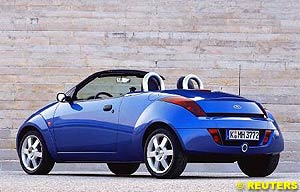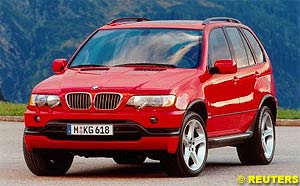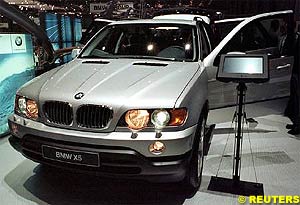

Automotive News and Reviews for the Petrolhead
Reuters Motoring Commentator
In this week's issue:
- Germans Beating US Luxury Car Brands
- The Future is Bright for Mini Roadsters
- Why the BMW X5 is a Great 4X4
Try as they might, the world's two biggest automakers cannot catch up with the powerful Germans in the luxury segment, and they will need to pour in a good deal more cash to make headway, analysts say.
"I don't think (Ford and GM) will ever catch up with the Germans in this segment," said Himanshu Patel, an analyst at JP Morgan in London.
Ford and GM have failed to capture drivers' imagination with their models and to invest in a broad enough range, say analysts. In addition, closer integration and parts sharing could have led to greater cost savings, they argue.
While the German companies churn out strong profits and operating margins of five to eight percent year after year GM's Saab is losing money and Ford's Volvo was unable to offset a $500 million loss at Jaguar last year. Ford declines to break out figures for its individual brands but most analysts doubt Land Rover is making money.
The Detroit companies, with headaches of their own including ballooning pension obligations and high levels of profit-eating incentives, can ill afford extra liabilities.
Ford Stands to Lose More
Yet the U.S.-owned brands, acquired several years ago to boost market share in the high-margin segment, rake in higher profits and improve overall quality, are an important plank of the companies' strategies and neither group looks poised to sell out.
"This is a very serious set of circumstances, especially for Ford," said Garel Rhys, a motor industry researcher at Cardiff University in the UK
Ford, in the midst of a multi-year turnaround plan after a $5.45 billion loss in 2001, stands to lose more. Its luxury brands are supposed to generate over a third of group profits by mid decade -- an increasingly ambitious-looking target for the Premier Automotive Group of luxury brands.
Experts say annual unit sales will have to rise by 80 percent to achieve that.
"PAG is an essential part of Ford's profit forecasts and if it doesn't meet its targets, it will cause the whole company a problem," said one London-based analyst.
Companies keep mum about how much they spend on developing individual models, but analysts believe the Germans have invested more in the last few years on product and that has resulted in a formidable range of mainstream luxury saloons. Ford and GM are now playing catch up but they may be too late.
"Some may say the Germans are obsessed with high quality engineering and that they spend too much on it, but it seems to have stood them in good stead," said one analyst.
'A Tricky Balance'
The departure last year of former BMW executive Wolfgang Reitzle from the helm of Ford's PAG exemplifies the difference in attitudes towards product spending between Germans and Americans. One of the reasons he quit PAG was allegedly the lack of cash he was given to develop new products, even as Ford sank into heavy losses.
"The trouble is, although you can boost profits in the short term by cutting capacity to match demand, it is not the route to long-term salvation," said Rhys.
Ford and GM have tried to cut costs by axing jobs and trimming capacity but further integration of their European units into the parent company will be needed to maximise savings obtained through measures like increased parts sharing.
"It is always a tricky balance to enhance cost savings by sharing parts and preserving the identity of the individual marque, but there is plenty of potential with GM, Ford and their upmarket brands," said the London-based analyst, noting that Saab could share engines with some GM models.
Saab has lost money in 10 of the last 12 years as it failed to deliver cars that were as fashionable as in the last 1980s. It has slashed its sales forecasts and last year said it would cut about 20 percent of its workforce, or about 1,300 jobs.
Although a quirky brand, Saab is not mainstream enough to poach Audi, BMW or Mercedes buyers. But as GM's only global luxury marque -- Cadillac is limited to the U.S. -- it is important to GM. The company acknowledges the challenge.
"I am modest, I don't think we will, in two or three years, be up there with the likes of Audi and BMW. It will be a long time, but it is a guiding star," said Saab chief Peter Augustsson in November.
Written by Madeline Chambers
It has long been clear that the terms of our relationship with the car must change.
The new generation 'minis' are no longer the equivalent of school dinners, simply doing the job at a minimal cost but leaving you wishing you'd rather not bothered. The world's motor manufacturers have been aware of their obligation to develop more efficient motoring solutions for some time, and the exotic results of expensive design studies have been routinely unveiled at motor shows around the world for many years.
But now the emphasis has changed. Manufacturers use these events as very public customer clinics to elicit critical reaction to much more highly developed concepts before making a final decision on production. Consumer reaction is proving to be overwhelmingly positive to a new generation of vehicles and seemingly the public gets what the public wants. This year a mouth-watering selection of small cars looks set to appear in UK showrooms, sometimes as a direct result of British opinion.
The Daihatsu Copen is just such a car. In its home market of Japan, this stunning automotive toddler went on sale last year and there are still queues outside Daihatsu dealers now. It's not difficult to see why. This diminutive convertible's hard-top roof can be raised or lowered in 25 seconds, at the touch of a button.
It boasts a turbo-charged 660cc 4-cylinder engine and, despite being just 3.4 metres long, has been cleverly designed to offer head and leg room for six-footers. Currently the Copen is only being built to Japanese regulations and does not have Type Approval for export to the UK, but at October's Birmingham Motor Show Daihatsu received in excess of 1,500 serious enquiries from the public.
Keep your fingers crossed, but the UK importer is resolute about bringing the Copen to Britain this year. Daihatsu's UK Aftersales Director, Roy Marshall, has said, "Prior to the Motor Show we were working to overcome the technical obstacles. Now we are even more determined to find solutions in order to satisfy the obvious high demand for the car." When it happens, expect prices to be around 14,000 pounds."
One charming pocket drop-top you will see on our roads in the spring is the Ford StreetKa. Visual similarities to the hugely successful three-door hatchback Ka are little more than that; the StreetKa convertible roadster boasts an all-new chassis and is an excellent example of the sort of product manufacturers are developing for the 21st Century.
StreetKa can easily top 100mph, offers leather sports seats, a CD player and climate control but will also return almost 35mpg. Following its UK launch in October, Ford sold the first 1,000 examples in just three weeks but a further 5,000 right-hand-drive versions will be built this year. With prices starting at just 12,495 pounds you'll still need to beat a hasty path to your Ford dealer's door!
Perhaps this original Smart may just be a little too idiosyncratic looking for you, but now there is no excuse. Smart has launched the two-seat Roadster and Roadster-Coupe, due into the UK in the autumn (left-hand-drive versions go on sale in the spring). This latest Smart concept promises to recapture the spirit of roadsters from the Fifties and Sixties, combining grown-up rear-wheel-drive handling with low-weight and compact dimensions to deliver the sort of intoxicating driving experience that parks a permanent grin all over your face. There are both hard and soft-top options and the dynamic performance of the Roadster will not compromise fundamental Smart principals of functional practicality and ecological compassion.
For many, the need for four (or even five) seats would rule out options such as the StreetKa or Copen, but compact motoring can still be fun. The new Nissan Micra offers even more practicality than ever but is one of the funkiest shapes on the road; the Citroen C3 and Mercedes A Class are mini-MPV marvels and Fiat is even developing a baby 4x4 vehicle called the Simba.
Far from being numbered, the car's days would appear to be getting sunnier - quite literally in the case of the StreetKa, Copen and Smart Roadster.
For the benefit of the uninitiated, the BMW X5 is one of the world's great 4x4 sports utility vehicles (SUVs).
The market sector for these 'soft roaders' (4x4 vehicles that are more often valet parked in Kensington than wheel-deep in mud on a Welsh sheep farm) continues to grow steadily with the likes of BMW, Mercedes and now even Porsche muscling in on heartland Range Rover territory.
Each to their own, but the reasons for buying a 4.6iS X5 far outweigh the reasons not to. As standard, the lucky owner will enjoy legendary BMW build quality and engineering but the car's handling and performance are what justify the majority of the 54,000 pound price tag. As 'The Ultimate Driving Machine', BMWs are, of course, noted for their handling and performance and if the design team in Munich decided to build a fork lift truck, it would doubtless be the finest performing fork lift truck in the world. But 4x4 SUVs are tall, ungainly and heavy. Historically, they were neither conceived nor evolved as true driver's cars.
The standard X5 changed all of that. In its more humble guises (4.4i, 3.0i and 3.0 diesel) the car astounded the motoring press with its car-like driving experience and customers trusted every word, creating a waiting list for the X5 that leaves every BMW salesman foaming at the mouth. Where the average off-roader can feel quite slow, unresponsive and unwilling to corner at anything other than walking pace, the X5 is the complete opposite. Decent performance with minimal body roll and an excellent blend of communicative steering and mechanical grip mean the X5 is actually fun to drive. Fast, safe and rewarding.
And then there is the 347 bhp, 4.6 litre V8 version - the 4.6iS. Truly, this is the daddy. First impressions count double with this car. On first acquaintance you have no time to sit and soak-up the ambience or bother locating tertiary, secondary or even primary controls. It isn't big and it isn't clever, but your new best friends are the pedal under your right foot and the steering wheel in your hands. This car is so fast that you have to pinch yourself to remember it's a lofty, heavy 4x4. Except you can't, because you need both hands on the wheel.
In truth, this X5 is as fast as you want to drive it and can be as relaxing as it is fun, but be under no illusion about its own aspirations. This is a performance car and the evidence is all too apparent, both positive and negative. On the plus side, not only will your right foot offer a clear signal of intent, but the gearbox is equally performance orientated. As standard, the 4.6iS comes with BMW's 5-speed Steptronic automatic transmission, programmed to optimise the sporting characteristics of the car.
Aside from a choice of fully auto settings, more committed drivers can flick the gearbox into a clutchless semi-automatic mode. You will now have to steer with just the one hand on occasions, using the left hand to shift sequentially up and down the 5-speed gearbox. It is certainly fun although far from a genuine sequential experience as the clever electronics will override your own input should you make a mistake, avoiding over-revving the engine.
Behind the wheel of this car is a great place to be. Once adjusted to the shattering performance and driving experience, attention will naturally wander to what the cabin has to offer. Electronically adjustable heated front seats, Nappa leather upholstery and a 10 speaker / 6 CD autochanger audio system certainly help justify the mighty price tag. As ever with BMW though, it is the detail that impresses most.
Everything feels 'correct'. The materials used are of the quality you expect, and the tactility of various switches and controls inspires confidence at all times. Externally, the car certainly looks the part, although what that part may be will differ, depending upon your perspective.
It would not be unreasonable to politely suggest this particular X5 displays more 'youthful' appeal. You can draw your own conclusions of the semi-darkened rearward windows, alarmingly expensive 20" alloy rims and massive twin chrome rear exhaust pipes.
If you are in the market for a high-performance luxury 4x4 vehicle, the X5 4.6iS will be hard to resist. Its closest competitors (and the list is not long) cannot quite match its all-round competency. The new Range Rover is a stunning vehicle and is almost certainly a better off-road bet, but is not the driver's car the X5 is.
You have to buy a heavily modified, AMG-tuned version of the M Class Mercedes to achieve similar levels of performance but, although we have yet to drive one, there are question marks over its build quality. And finally, the brand new Porsche Cayenne Turbo costs a sobering 70,000 pounds and is anything but easy-on-the-eye. Purely subjective, but hard to deny.
In the final analysis, the X5 is a unique blend of suitably imperious presence and street-wise savvy. And judging by the waiting list, there are plenty of people who'd agree.
![]() Germans Beating US Luxury Car Brands
Germans Beating US Luxury Car Brands
 A broad range of finely engineered, high quality cars has handed BMW, Mercedes and Audi sales volume and pricing power their American peers can only dream of in Europe and increasingly in the United States. Last year, General Motors' Saab, Ford's Volvo and Jaguar together had a 1.3 percent slice of the U.S. market, roughly equal to Mercedes and BMW individually. The situation is even more extreme in Europe.
A broad range of finely engineered, high quality cars has handed BMW, Mercedes and Audi sales volume and pricing power their American peers can only dream of in Europe and increasingly in the United States. Last year, General Motors' Saab, Ford's Volvo and Jaguar together had a 1.3 percent slice of the U.S. market, roughly equal to Mercedes and BMW individually. The situation is even more extreme in Europe.
 While most analysts respect the engineering and styling on models such as Volvo's S60 and larger S80, Land Rover's Range Rover, Jaguar's flagship XJ sedan and small X-type, Ford has yet to reap the rewards from its investment.
While most analysts respect the engineering and styling on models such as Volvo's S60 and larger S80, Land Rover's Range Rover, Jaguar's flagship XJ sedan and small X-type, Ford has yet to reap the rewards from its investment.
![]() The Future is Bright for Mini Roadsters
The Future is Bright for Mini Roadsters
 Anyone who lives or works in a UK city will confirm that there is less room than ever for all the cars we apparently need. And you don't have to subscribe to a fanatical eco-group to realise there is a multitude of sound environmental reasons why manufacturers must make cars more efficient. Well, they are, and in a big way.
Anyone who lives or works in a UK city will confirm that there is less room than ever for all the cars we apparently need. And you don't have to subscribe to a fanatical eco-group to realise there is a multitude of sound environmental reasons why manufacturers must make cars more efficient. Well, they are, and in a big way.
 Of course, when it comes to thinking compact city cars, you really have to think smart. Or Smart even. This DaimlerChrysler-owned company has sold more than 16,000 examples of its City model in Britain and for the motorist with a conscience, it is a truly unique proposition. Combining Tardis-like interior space (for two!) with a 2.5 metre body length (and just 720kg kerbside weight) the City Coupe (or Cabrio) will deliver 60mpg, CO2 emissions of just 113g/km and prices start from just £6,265. You can park them front on to the pavement, two will fit into most parking bays, and the turbo-charged 3 cylinder engine is powerful enough to let you nip in-and-out of city traffic as if it really wasn't there.
Of course, when it comes to thinking compact city cars, you really have to think smart. Or Smart even. This DaimlerChrysler-owned company has sold more than 16,000 examples of its City model in Britain and for the motorist with a conscience, it is a truly unique proposition. Combining Tardis-like interior space (for two!) with a 2.5 metre body length (and just 720kg kerbside weight) the City Coupe (or Cabrio) will deliver 60mpg, CO2 emissions of just 113g/km and prices start from just £6,265. You can park them front on to the pavement, two will fit into most parking bays, and the turbo-charged 3 cylinder engine is powerful enough to let you nip in-and-out of city traffic as if it really wasn't there.
![]() Why the BMW X5 is a Great 4X4
Why the BMW X5 is a Great 4X4
 It is important to establish what the purpose of a 'soft-roader' is. The X5's off-road capability has not been put to the test here and it is as different a proposition to a Land Rover Defender, for example, as chalk is from cheese. Whatever the appeal of a tall, capacious 4x4 vehicle may be, for most people it does not include spending time playing in a field. More sure-footed handling in wintry conditions? Yes. A greater sense of safety and security for your family? Of course. An overwhelming sense of superiority whilst sitting at the traffic lights? No question.
It is important to establish what the purpose of a 'soft-roader' is. The X5's off-road capability has not been put to the test here and it is as different a proposition to a Land Rover Defender, for example, as chalk is from cheese. Whatever the appeal of a tall, capacious 4x4 vehicle may be, for most people it does not include spending time playing in a field. More sure-footed handling in wintry conditions? Yes. A greater sense of safety and security for your family? Of course. An overwhelming sense of superiority whilst sitting at the traffic lights? No question.
 The negative implications of such indulgent antics will be felt in your wallet, regularly. Manufacturer-quoted fuel-consumption statistics suggest a combined cycle (all driving conditions) figure of 19 miles to the gallon. In the real world, it costs around 70 pounds to fill this X5 up and, depending upon how you drive of course, around 250 miles later, you'll be doing it again.
The negative implications of such indulgent antics will be felt in your wallet, regularly. Manufacturer-quoted fuel-consumption statistics suggest a combined cycle (all driving conditions) figure of 19 miles to the gallon. In the real world, it costs around 70 pounds to fill this X5 up and, depending upon how you drive of course, around 250 miles later, you'll be doing it again.
© 2007 autosport.com . This service is provided under the Atlas F1 terms and conditions.
|
Volume 9, Issue 7
Atlas F1 Special
Interview with Ralph Firman
The Cult of a Personality, II
The FIASCO War Continues
Columns
Off-Season Strokes
The F1 Trivia Quiz
On The Road
Elsewhere in Racing
The Weekly Grapevine
> Homepage |